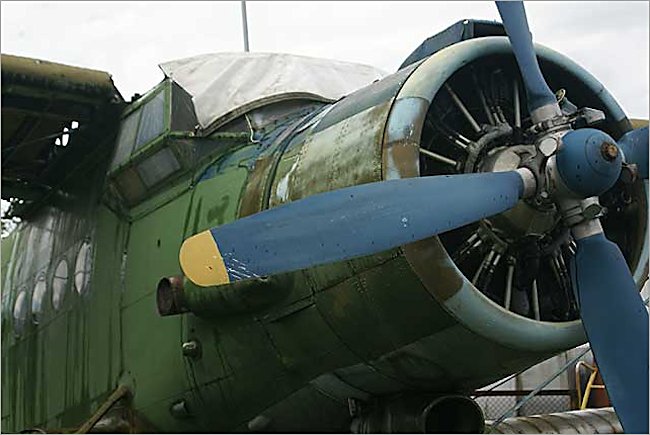Antonov An-2 Colt Biplane
The Antonov An-2 Colt light multi-purpose aircraft is the largest two winged biplane in the world that is still flying. The Antonov An-2 maximum speed was 250 km/h with a cruising speed of 185 km/h. It has a range of 2000 km and can fly at an altitude of 4400 m. It needs a crew of 2 and can carry 12 passengers or a load of 1300 kg. NATO gave it the reporting code name of Colt.
It was designed as the replacement for the Polikarpov Po-2 which was used in large numbers as both an agricultural aircraft and a utility aircraft. The second prototype was fitted with a more powerful Shvetsov ASh-62 engine, which allowed the aircraft's payload to be significantly increased from 1,300 kg (2,870 lb) to 2,140 kg (4,720 lb).

Photograph taken at the Russian Aircraft Museum next to Riga International Airport Latvia
The Antonov An-2 first flight was on 31st August 1947. In August 1948 An-2 entered Aeroflot service. The aircraft was designed as agricultural aircraft not military, but soon it became multi-purpose thanks to its reliability and performance. Eighteen variants were built. Production in the Soviet Union ended in 1960 after more than 5000 aircraft had been built
Polish aircraft producing corporation WSK - Mielec also built the Antonov An-2 biplane under license. They built more than 12000 aircraft (10440 of them were bought by the USSR). Production stopped in Poland in 1992. China also bought the license to produce the Antonov An-2 biplane and was producing them until 1995 (950 copies were built) under designation Y-5.
Antonov biplanes are still flying all over the world. Twenty six countries have bought them for their air forces and civil organizations. However, despite of its archaic look the basic airframe is highly adaptable and numerous variants have been developed. These include hopper-equipped versions for crop-dusting, scientific versions for atmospheric sampling, water-bombers for fighting forest-fires, flying ambulances, float-equipped seaplane versions, lightly armed combat versions for dropping paratroops, and of course the most common An-2T version, which is the 12-seater passenger aircraft. An-2 is very popular among civilian parachute clubs. Some aircraft were fitted with floats for landing on water.
The Antonov An-2 biplanes were used in the Korean War. During the 1960s an An-2 attempting to engage South Vietnamese naval units was shot down by an F-4 Phantom II from the USS Long Beach. Not a very fair contest. In the Vietnam War the An-2 was used as a naval interceptor and had been modified to carry two Skvall torpedoes under the wing. The planes low speed did make it tricky for fast jets to intercept it as it could fly slower than the jets landing speed. At those slow speeds it could ground hug under radar to help it evade detection. The chief advantage for the An-2 was that they could take off and land in small or improvised airstrips.
During the Croatian War of Independence in 1991, a few old Antonov An-2 biplanes used for crop-spraying were converted by the Croatian Air Force to drop makeshift bombs and were used in supply missions to the town of Vukovar and other besieged parts of Croatia. They were also used to drop supplies by parachute on isolated garrisons. At least one was shot down on 2 December 1991 over Vincovci, eastern Slavonia, by Serbian SAM missiles, purportedly SA-6s
The Riga Museum's aircraft was towed by Viktor Talpa from Nakotne. It was in very bad condition, almost completely disassembled. Museum aircraft is coded 22-yellow and has c/n 11047307 (first digit means nothing, 10 is the batch number, 473 is the Kiev Aviation Plant (nowadays "Aviant") number and 07 aircraft number in the batch).